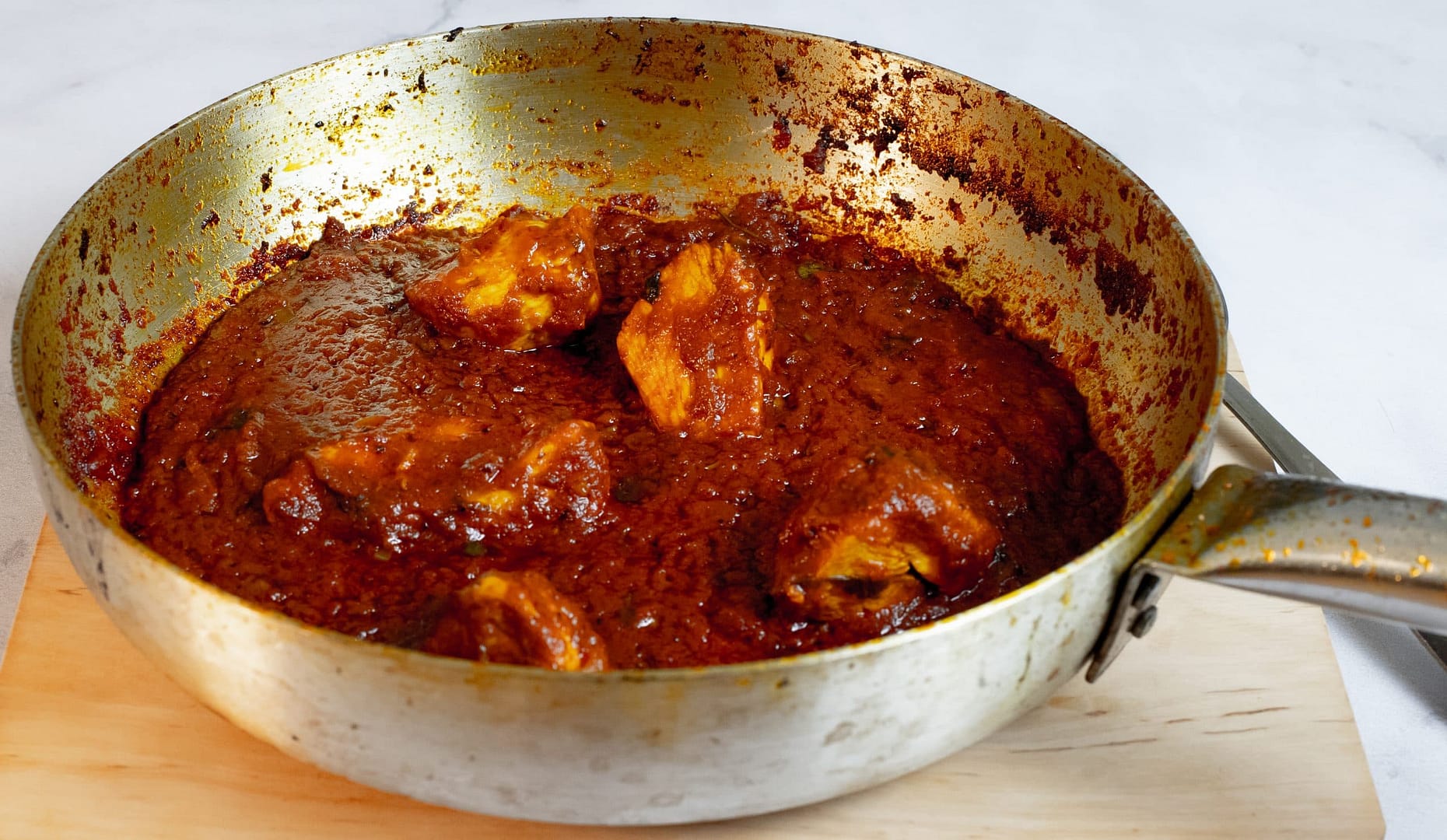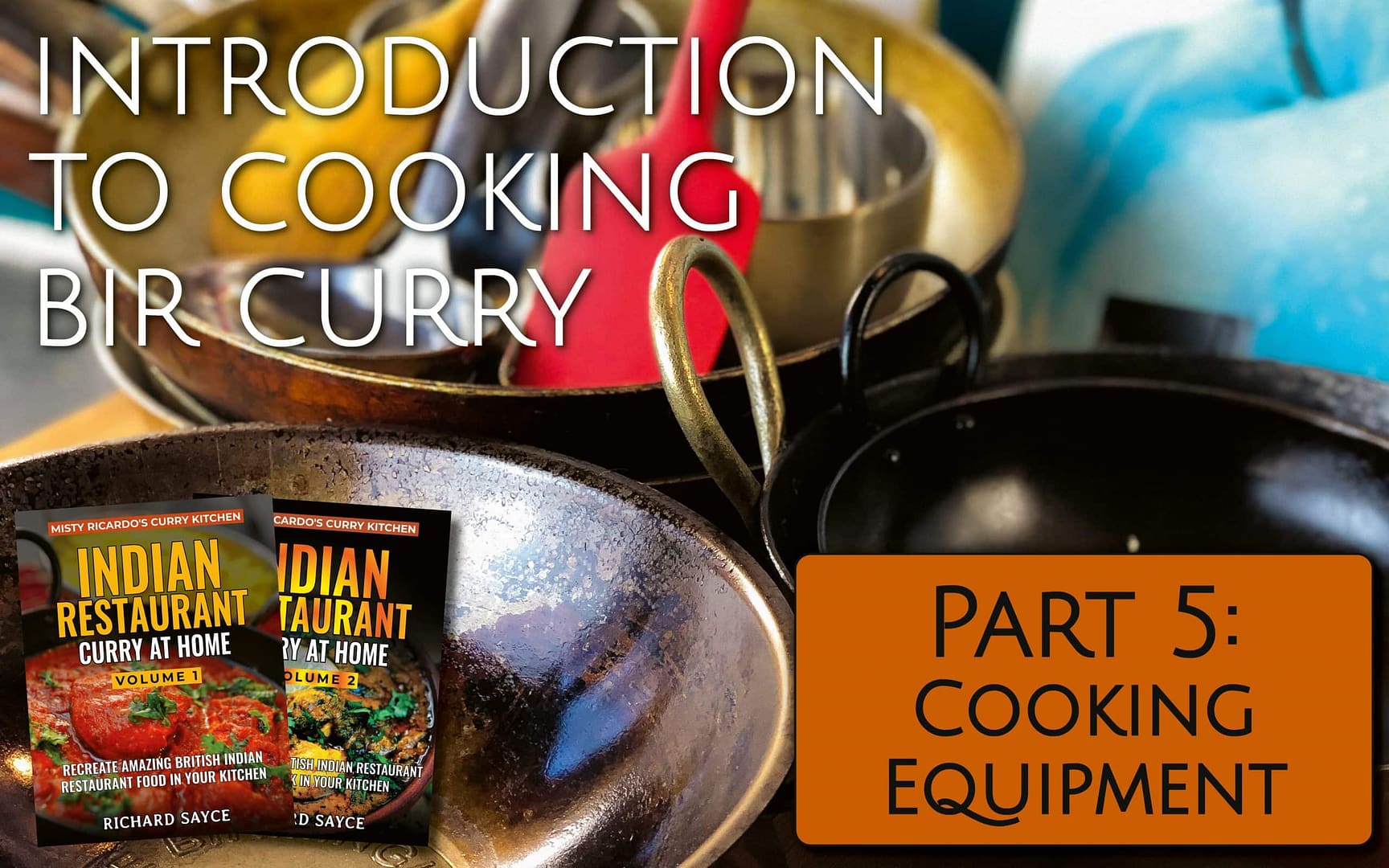Frying Pan
You can cook curry in any type of frying pan, but for the best results use an aluminium one that’s not non-stick.
Aluminium is a metal with excellent heat conductivity, fast temperature adjustment, is light but durable, and distributes the heat evenly. A disadvantage, however, is that aluminium pans do not work on induction hobs.

Stainless steel or iron pans have some of those advantages, but they don’t spread the heat evenly. This means it’s harder to make best use of cooking techniques, and it’s easier to burn the contents.
Space Holder
Pans with Teflon non-stick coating are probably the least favourable for cooking British Indian Restaurant (BIR) curries, although it is possible to get good results. The non-stick coating slows down heat conductivity, and, of course, it stops the pan contents from sticking. This is great if you’re frying an egg, but in BIR cooking it’s preferable to have the curry adhere to the pan a little and caramelise for the best flavour.
I recommend using a frying pan that has the smallest diameter you feel comfortable using. The smaller the pan, the less weight it has, which means more heat energy goes into the pan contents, allowing for a higher temperature to be reached and maintained. For the typical size of curry you might get from an Indian takeaway, a 24cm (rim-to-rim diameter) pan is usually sufficient. A 26cm size is a good all-rounder (no pun intended) for larger portions. I would avoid larger frying pans when cooking single portion curries.
Korai
Also sometimes known as ‘kadai’ or ‘karahi’, these pressed steel or cast iron dome-shaped pans are fun and authentic to cook in, and have a thicker surface than woks or frying pans. The thicker ones retain heat very well but are sluggish to gain or lose temperature. With practice you can overcome this and control the heat effectively to take advantage of the higher maximum temperature at the right time in the cooking process.

Space Holder
For some inexplicable reason balti and karahi curries seem to taste better when prepared in a korai. Use one that’s just big enough for all the ingredients for optimal heat efficiency.
Pans with Teflon non-stick coating are probably the least favourable for cooking British Indian Restaurant (BIR) curries, although it is possible to get good results. The non-stick coating slows down heat conductivity, and, of course, it stops the pan contents from sticking. This is great if you’re frying an egg, but in BIR cooking it’s preferable to have the curry adhere to the pan a little and caramelise for the best flavour.
I recommend using a frying pan that has the smallest diameter you feel comfortable using. The smaller the pan, the less weight it has, which means more heat energy goes into the pan contents, allowing for a higher temperature to be reached and maintained. For the typical size of curry you might get from an Indian takeaway, a 24cm (rim-to-rim diameter) pan is usually sufficient. A 26cm size is a good all-rounder (no pun intended) for larger portions. I would avoid larger frying pans when cooking single portion curries.
Buy the Books
Wok
A thin steel wok is great for frying rice or scorching vegetables (for instance the onions and peppers for a jalfrezi curry). The high but thin sides maximise heat input while reducing spillage, and allow intense stir-frying without significant temperature loss.
Spoon or Spatula
Use any implement you want, provided it can stir and scrape quickly and efficiently. I often use a stainless-steel chef’s spoon, a wooden spatula, and a firm silicone spatula – though not necessarily at the same time! Some people dislike the sound that a metal spoon makes scraping on the pan, whereas others think using a wooden version is a bit ‘Delia Smith’ (no offence, Delia).
Saucepan & Ladle
To keep base gravy hot and ready to add when cooking curries, I suggest you have it slow simmering in a saucepan and use a ladle to dispense it. Most curry recipes in this book require about 350-400ml of (diluted) base gravy, so use a saucepan with enough capacity for as many curries you’re making in a session. Measure the millilitre capacity of your ladle and learn how much to fill it by eye with common amounts such as 30ml, 50ml, 75ml and 100ml. The ladle I use in the Misty Ricardo’s Curry Kitchen videos fills to 100ml.
Tava
A tava or tawa is a flat frying pan without sides, and is most commonly used for making chapatis. They are available in bare metal and non-stick varieties, with both having a different advantage. The non-stick variety is best for making chapatis because the dough will not stick to the surface and can be flipped easily. When making naan breads with a tava the bare metal variety is best as the naan dough will stick to the surface, and when the tava is flipped over the top side of the naan can be cooked directly over a flame. (See the Naan recipe on page 148 for more details.)
Stock Pot or Pressure Cooker
For making batches of base gravy, pre-cooking chicken, lamb, vegetables, cooking rice, dhal and so on, you’ll need a decent sized stock pot or pressure cooker. A 7-litre capacity pot should be enough, but if you plan to make larger batch sizes of base gravy, buy bigger. Most of the time I use a 7 or 8-litre pot, although I do own much bigger ones for ‘special’ occasions. But that’s a different story.
Food Processor or Stick Blender
Essential for blending base gravy, making pastes, and a variety of other tasks. I prefer to use a stick blender as it’s easier to clean than a food processor, but either is fine. If you are buying a stick blender invest in a good quality, powerful model. Cheaper versions don’t tend to last.
Measuring Spoons
With practice and experience you will learn to gauge a level teaspoon (5ml) or tablespoon (15ml) measurement by eye, and, like the pro BIR chefs, even be able to dip into spice powders with a cooking spoon and scoop them up accurately. In the meantime, play safe and use accurate measuring spoons. You will notice that my recipes use LEVEL spoon measures as standard unless stated otherwise.
Scales
I have included precise weights for ingredients in many of my recipes. Use accurate scales with a minimum resolution of 1g that can handle weights up to 5Kg. In addition, jewellery scales may come in handy for measuring spices at a finer resolution, such as one tenth of a gram, if you really feel the need.
Coffee/Spice Grinder or Pestle & Mortar
There’s no doubt that freshly ground whole spices are superior to the pre-ground versions sold. A coffee/spice grinder is a convenient and quick tool to use. A pestle & mortar, while being more traditional, needs more effort and time. It’s your choice: physical effort and desi-smugness, or speed and efficiency but with the added risk of making coffee that tastes of cumin.
Hob / Burner
Gas is preferred over electric for BIR cookery, which benefits from high and easily controllable heat. However, it’s perfectly possible to create restaurant quality BIR curry on an electric hob: it just takes a little more practice and skill.
This article features sample content from my first book, Indian Restaurant Curry at Home Volume 1.




0 Comments